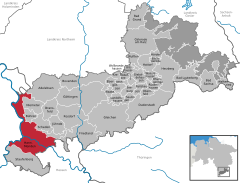Hann. Münden
Town in Lower Saxony, Germany From Wikipedia, the free encyclopedia
Town in Lower Saxony, Germany From Wikipedia, the free encyclopedia
Hann. Münden (short for Hannoversch Münden) is a town in Lower Saxony, Germany. Münden lies in the district of Göttingen at the confluence of the Fulda and Werra rivers, which join to form the Weser. It has about 24,000 inhabitants (2013). It is famous for its half-timbered houses, some of them more than 600 years old. There are 10 million cobblestones around the town.
You can help expand this article with text translated from the corresponding article in German. (March 2013) Click [show] for important translation instructions.
|
Hann. Münden | |
|---|---|
 Town hall | |
Location of Hann. Münden within Göttingen district  | |
| Coordinates: 51°25′N 09°39′E | |
| Country | Germany |
| State | Lower Saxony |
| District | Göttingen |
| Subdivisions | 11 |
| Government | |
| • Mayor (2021–26) | Tobias Dannenberg[1] (CDU) |
| Area | |
| • Total | 121.12 km2 (46.76 sq mi) |
| Elevation | 123 m (404 ft) |
| Population (2022-12-31)[2] | |
| • Total | 23,530 |
| • Density | 190/km2 (500/sq mi) |
| Time zone | UTC+01:00 (CET) |
| • Summer (DST) | UTC+02:00 (CEST) |
| Postal codes | 34346 |
| Dialling codes | 05541 |
| Vehicle registration | GÖ, DUD, HMÜ |
| Website | www.hann.muenden.de |


The place is first mentioned in the deeds of donation of Gimundi to the abbey of Fulda, in 802. The town's name means "confluence" in old German; the prefix Hannoversch, or "Hanoverian", was added in the 19th century to help distinguish the town from its similarly-named Prussian neighbour, Minden.
City rights might have been granted during the latter half of the 12th century.[3]
The French inventor Denis Papin built a steam-pump-powered paddlewheel boat, probably pedal-driven in 1704, and as a demonstration used it to navigate down the Fulda River from Kassel to Münden in 1707.[4]
Hann. Münden was the site of the Royal Prussian Academy of Forestry: the city's botanical gardens with many different trees were primarily established for this academy. Later the academy was merged into the University of Göttingen, moving to a new building on the main campus in 1970.[5]
Many tourists visit the city to see its some 700 well-preserved half-timbered medieval houses.
The large Lutheran church of St Blasius (14th–15th centuries), in Gothic style, contains the sarcophagus of Duke Eric I of Brunswick-Calenberg (d. 1540).[3]
Other sights include:

Seamless Wikipedia browsing. On steroids.
Every time you click a link to Wikipedia, Wiktionary or Wikiquote in your browser's search results, it will show the modern Wikiwand interface.
Wikiwand extension is a five stars, simple, with minimum permission required to keep your browsing private, safe and transparent.